Many people consider white as a peaceful and a positive color. As such it would be handy to add a touch of whitish color to your garden as well. So, white succulent would grace your garden for sure.
Not only that but also, those succulents will add a right touch of brightness to your garden. In addition to this, you could consider using them for centerpieces and for living wall projects as well.
If you prefer to have a furry, alabaster cactus or even a frosty succulent you could go ahead with one of the white succulent which we are going to discuss in detail below.
Echeveria lauii
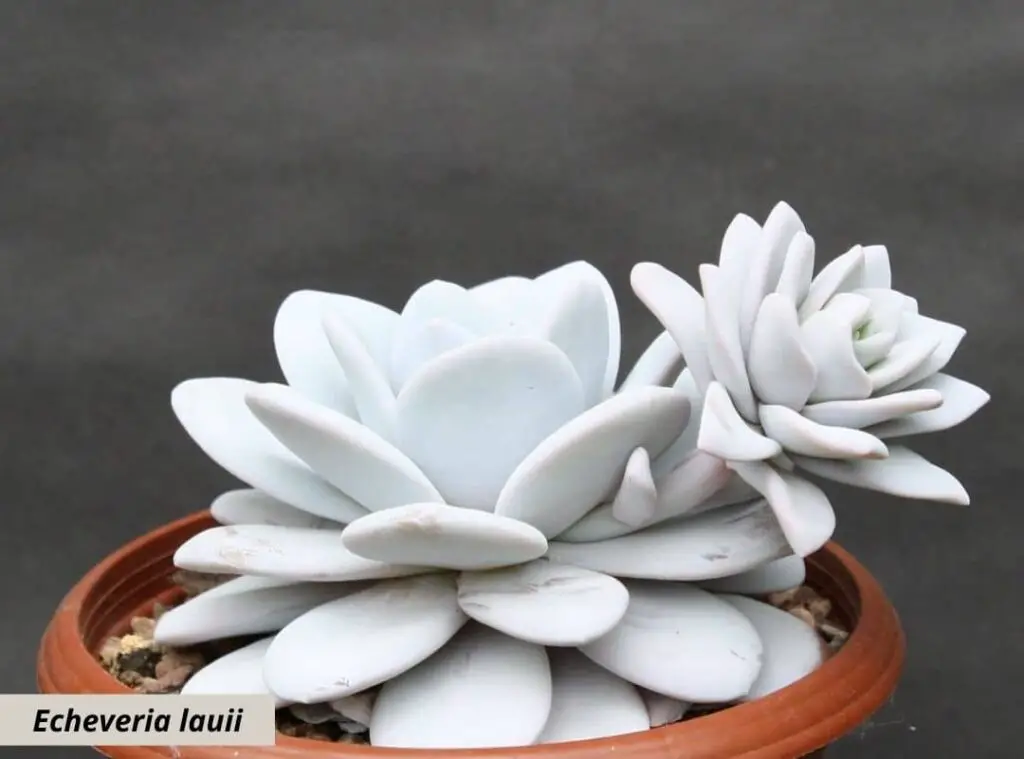
Echeveria Lauii is an unbranched white succulent which usually has powdery blue gray, white colored leaves.
They would usually rise to a height of 6 inches when they are fully matured. However, it will take many years for them to mature and achieve this height.
They tend to form in rosette manner and those could be about 5 inches in diameter.
These plants are a slow growing set of plants. Echeveria Lauii plants are native plants in Mexico, South America.
They would usually prefer to grow in USDA zones 9b-11b (-3.9°C or 25°F). They would grow vigorously outdoors, and it is quite common to spot them being grown outdoors.
However, you could grow them as decorative plants indoors as well. In terms of flowering, they would produce peachy rose-colored flowers.
Senecio haworthii
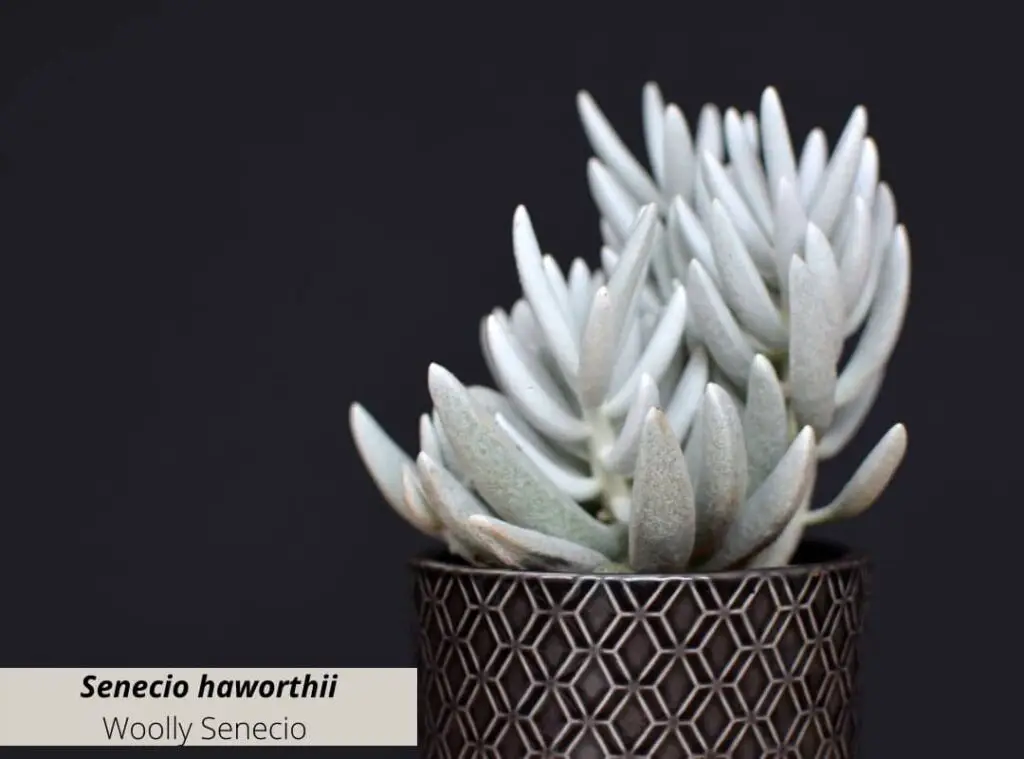
Woolly Senecio usually tends to look like the rest of other Senecio. However the only difference would be the covering on its leaves.
Woolly Senecio are originating from South Africa. They would be about 12 inches high when they are in full maturity.
In terms of flowering, they would produce vibrant, yellow-colored flowers.
This plant is a perennial white succulent, and they usually grow as dwarf shrubs. Further they would grow in an upright manner along with cylindrical shaped succulents’ leaves.
Those succulents’ leaves would be usually pure white as they have fine white hairs which would be covering the entire surface of the leaves.
Their preferred USDA zones are 9b-11b. 25° – 50° degrees Fahrenheit (-4° C – 10° C). Woolly Senecio would be quite handy to use as an indoor plant due to its unique looks.
Best is to grow them as ornamental plants indoors. Moreover, you could grow them as outdoor plants as well.
Espostoa melanostele
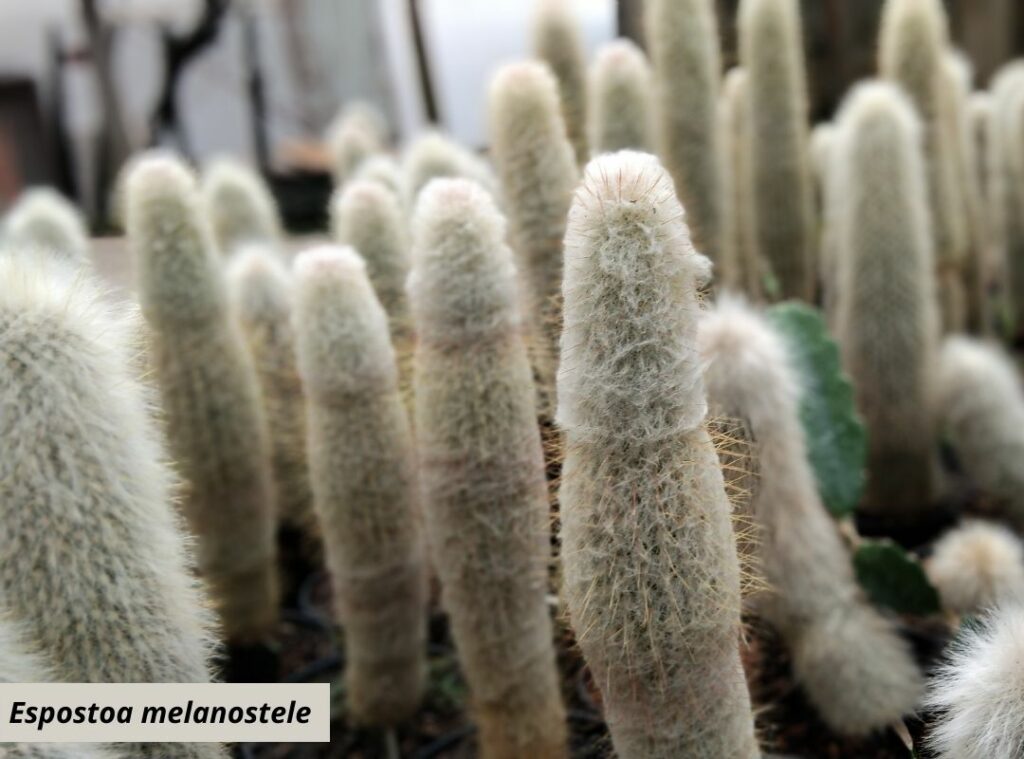
Espostoa melanostele or Peruvian Old lady cactus is an enchanting plant which could rise to 12 inches in height when they usually get matured.
This plant comprises a vertically growing stem. Hence, they are regarded as columnar cactus. You could spot their spines in golden yellow along with its hue in white.
That would look like a wool coating. They would take one whole year to grow from an inch. They would produce pink colored flowers as well.
These are not frost hardy plants. Hence you need to protect them from extreme temperatures. They will perfectly fit in as an outdoor plant if you live in 9b-11b 25 °F (−3.9 °C) to 50 °F (+10 °C).
Having said that, you could grow them as indoor plants as well. These plants are native plants in southern Ecuador and in Peru.
Espostoopsis dybowskii
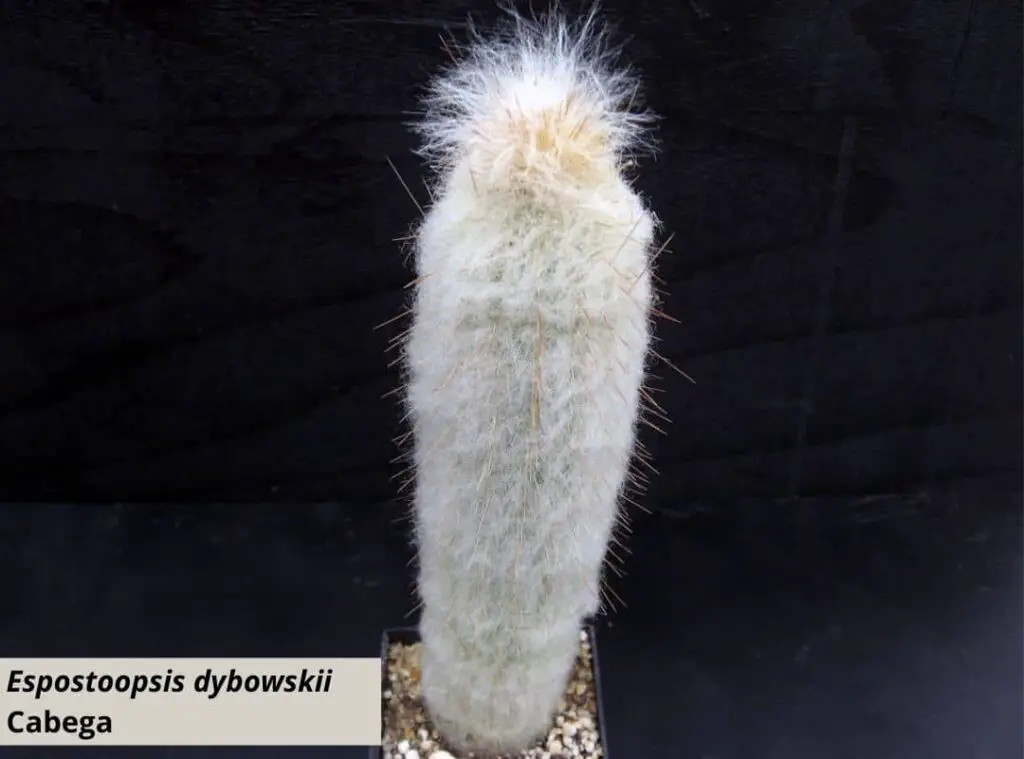
Espostoopsis dybowskii tend to grow more like Peruvian Old Lady cactus which we explained above. However, this plant is endemic to Brazil.
Espostoopsis dybowskii is a ribbed columnar cactus. They also comprise woolly white hairs which cover the stem surface.
That is what makes this plant look like a white succulent. In addition to that you could see how those long spines extended throughout the white hairs.
This is in fact an uncommon species. However, it is very rare to see them being grown in containers as they are very unlikely that they will achieve their maturity when grown in containers.
You could grow them outdoors if you live in their recommended USDA zones. You could expect them to flower with white blooms. Their preferred USDA hardiness zone is zone 10.
Euphorbia polygona
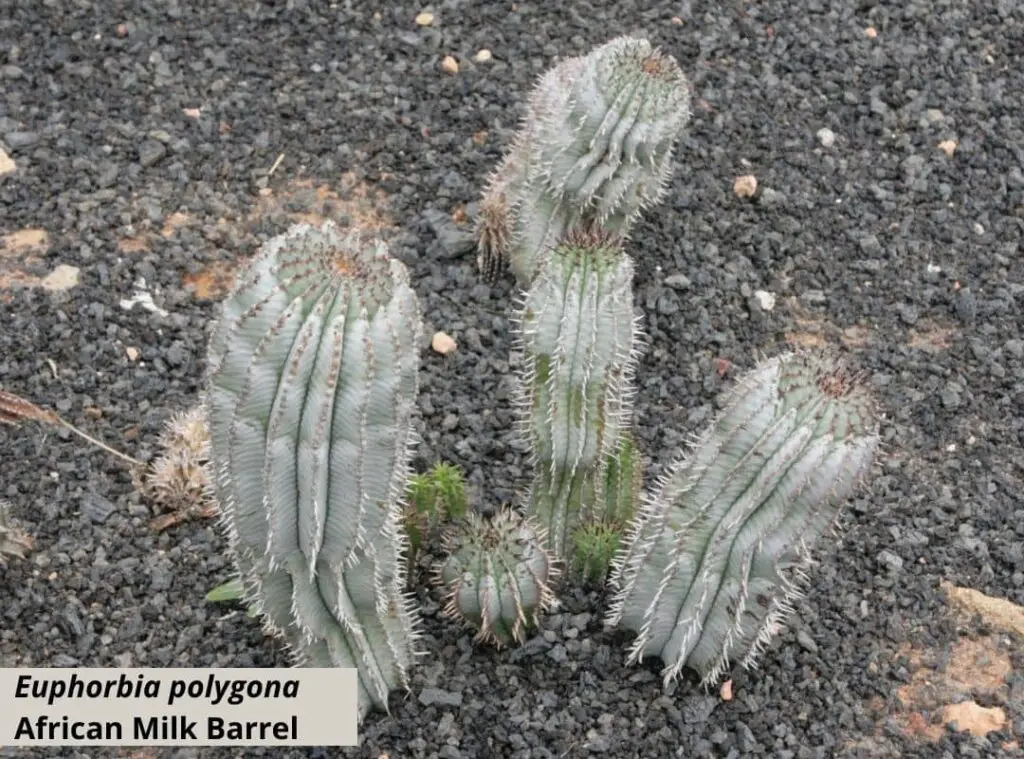
African milk barrel cactus are native plants in South Africa. They usually grow in clumps. Their stems usually consist of densely grown spines
It is ribbed and white in color. That gives a very nice chalky white appearance for the plant. Further its undertone could be green.
Their stems could be five feet in height and four inches in diameter.
These plants are not cold hardy. As such if you do not live in their preferred usda zones and if you live in a place where the temperature gets colder than 20 degrees Fahrenheit (-6.7 degrees Celsius), you could consider growing them as indoor plants.
Their preferred USDA zones are 9b-11b and you could grow them as outdoors plants in these zones.
Crassula ovata
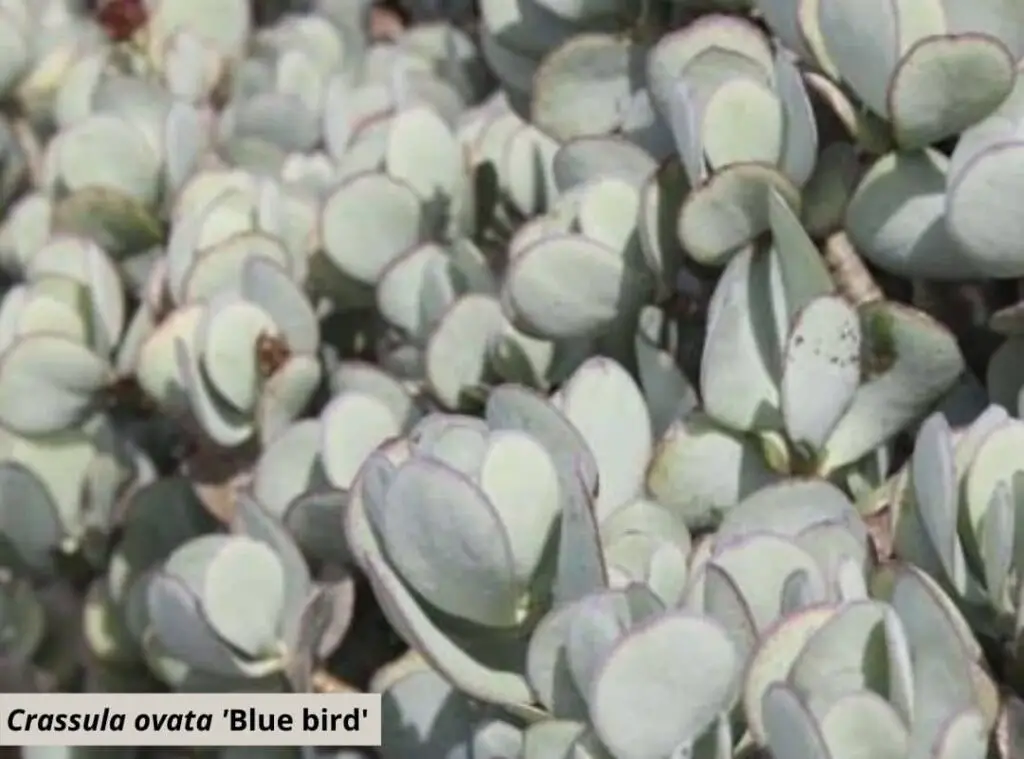
Blue bird plants usually form in a green and white variegated pattern. Their leaves would be round in shape and fleshy to the touch.
Their leaves would be carrying stripes in creamy white or pale yellow. They would rise to 1 foot in height when they are in their full maturity given that they get all their basic growing requirements fulfilled.
On the other hand, tri color leaves would be 2 inches in yellow.
This white succulent bloom with white flowers. They usually tend to show a slow growth rate. We are yet to discover the origin of this plant.
Blue bird plants would prefer to grow in USDA hardiness zones 10a-11b. You could grow this plant indoors in a cute looking pot.
Further you could grow them as outdoor plants also. When growing outdoors, they would tend to grow as mounding shrubs.
Haworthia maughanii
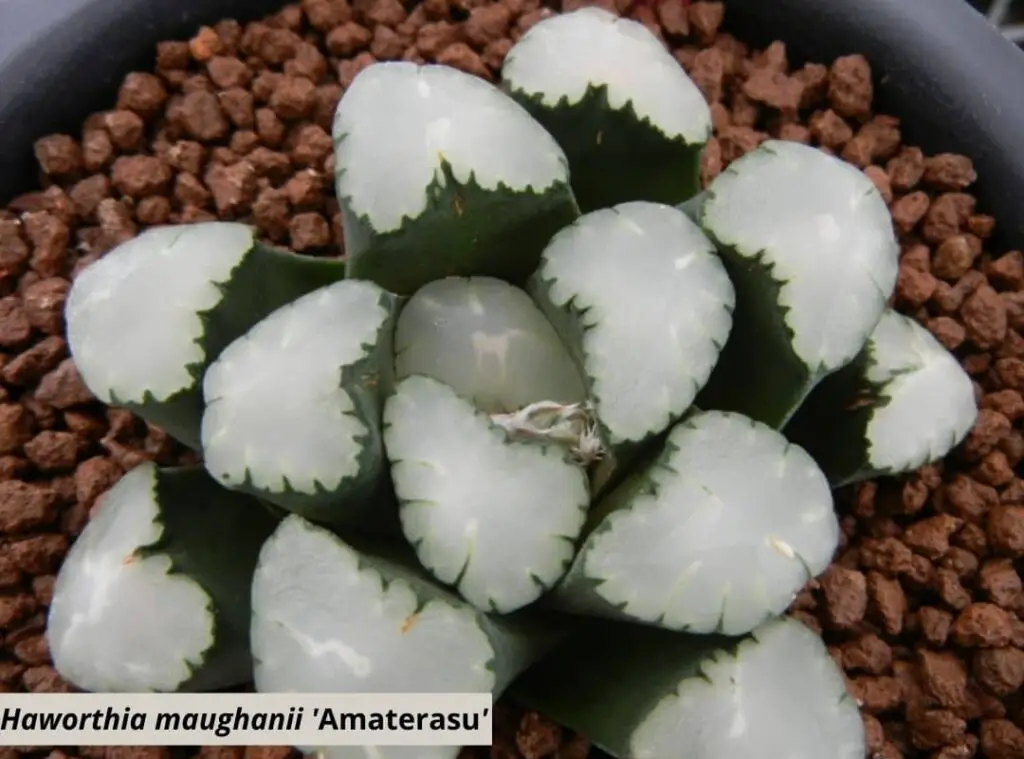
Haworthia maughanii are fleshy perennial herbs. Haworthia maughanii form in loose rosette shape. Their leaves are oblique from the plant base.
Moreover, Haworthia maughanii plants’ leaves at the top would be semi cylindrical shaped and truncated.
This white succulent leaves could be 2.5 cm in length and 1.5 cm in width. Further, those leaves are translucent too.
You could spot them in different varieties along with different patterns and with various colored leaves.
Haworthia maughanii plants are native plants in South Africa. They would usually rise to 20 cm in height. Further they will consist of florets 8-10, 1.2-1.3 in length.
They are white and could be spotted with green mid veins as well. Their preferred USDA zones would be 8b-10a. You could grow them as both indoor and outdoor plants.
Mammillaria gracilis
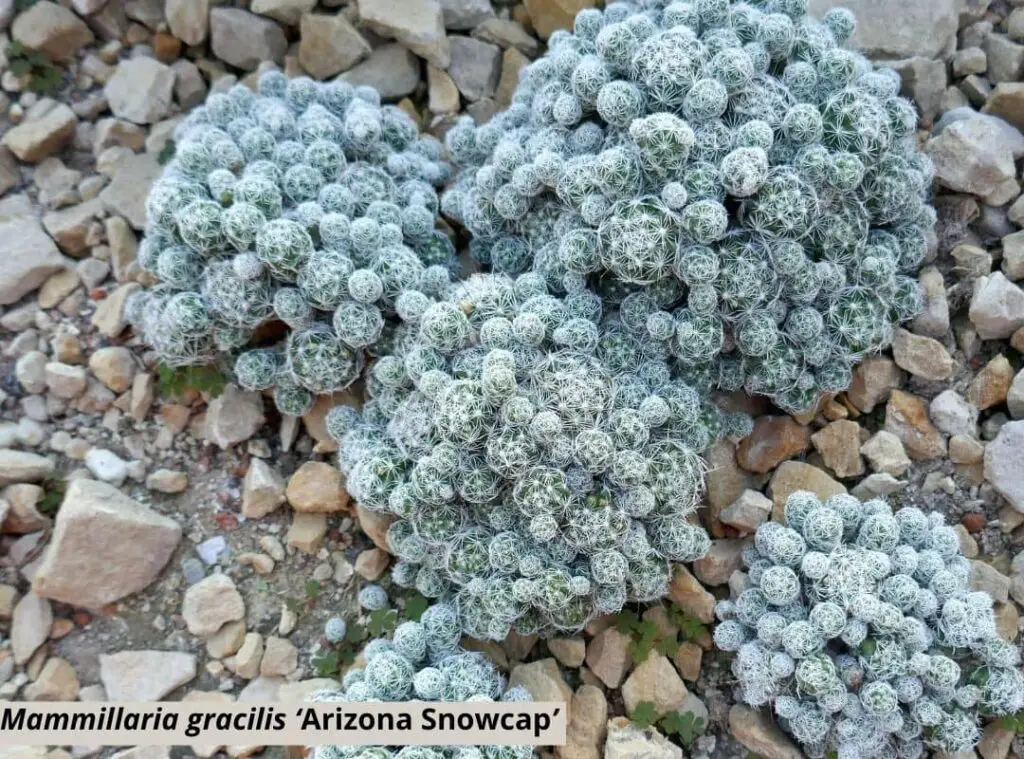
Mammillaria gracilis ‘Arizona Snowcap’ is a petite cactus. Further they produce many offsets as well. They would produce those offsets in clusters around the mother plant.
Their maximum height would be just 4 inches when they are in their full maturity. Arizona snow caps would usually consist of stems in green and they would be about one inch in width.
It would be somewhat challenging underneath the white spines layer.
Arizona snowcaps tend to grow in clumps in general. You could spot them forming with densely covered white silky hair all over the foliage.
they may look like powder puffs also. They would usually form yellow or white colored flowers. This white succulent is native to Mexico.
Their preferred USDA zones are 9-11. You could grow them as perfect outdoors plants in these zones. Apart from that, you could grow them as indoor plants as well.
Euphorbia lactea variegata
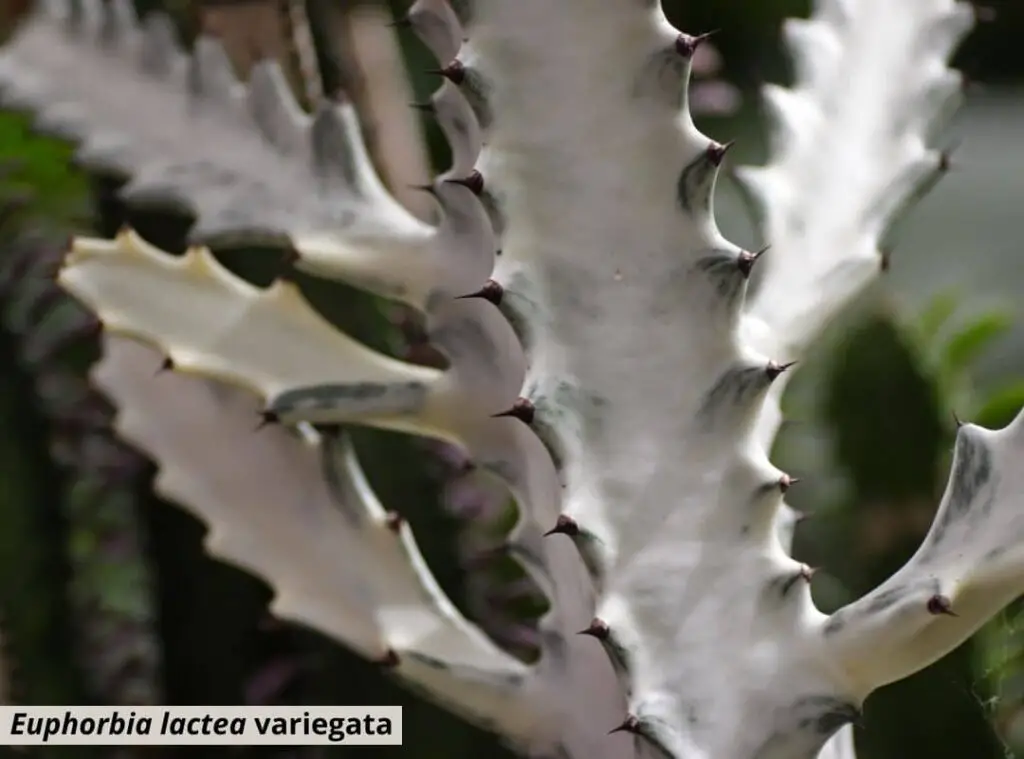
Euphorbia lactea variegata or the white ghost is a strange looking cactus. They do not consist of any chlorophyll or any other greener cultivator.
They would usually have stems which are triangular shaped and white in color. Further they form in a candelabra formation.
Not only that but also, you could spot them forming covered with short spines as well. Given that they get the right growing conditions they would be as tall as 10 feet.
Their preferred USDA hardiness zones are 10a-11b ( 30 degrees Fahrenheit to 50 degrees Fahrenheit).
This would be a great pick as an indoor plant, if you particularly live-in dry conditions.
On the other hand, if you live in warmer weather conditions, you could grow them outdoors as well. Euphorbia lactea variegata are native plants in India.
Dudleya gnoma ‘white Sprite’
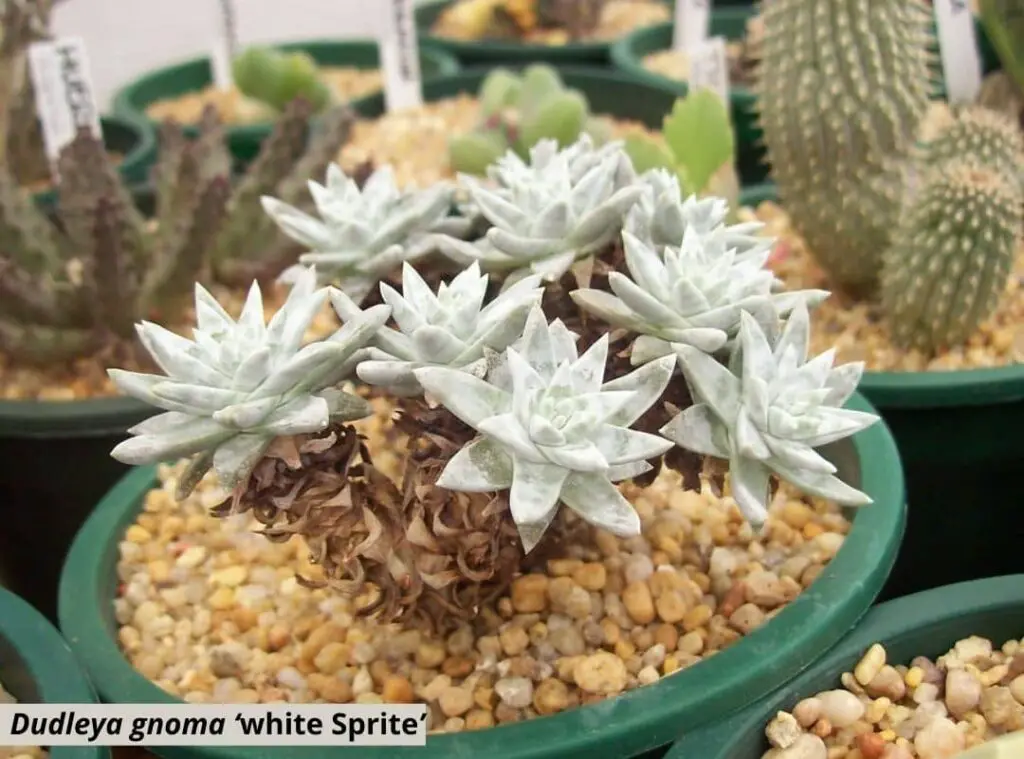
Dudleya gnoma ‘White Sprite’ tends to form in rosette patterns. Those rosettes would be 10cm in diameter.
On the other hand, their mounds can rise to 15 cm. White sprite pups usually form in clumps. You could spot their ghostly white leaves form in rosette types right on top of the thick stems.
Their leaves would be fleshy, triangular shaped and could be white in color.
They are so delicate. As such you need to be vigilant when handling them. Dudleya gnoma ‘White Sprite are native plants in Santa rosa island.
This white succulent would prefer to grow in USDA zones 9-12. They would produce flowers in white. Dudleya gnoma ‘White Sprite are a slow growing set of plants.
You could grow them as outdoor plants if you live in aforesaid zones. However, ensure that you do not expose them to frost. Alternatively, you could grow them as indoor plants.
Agave titanota .
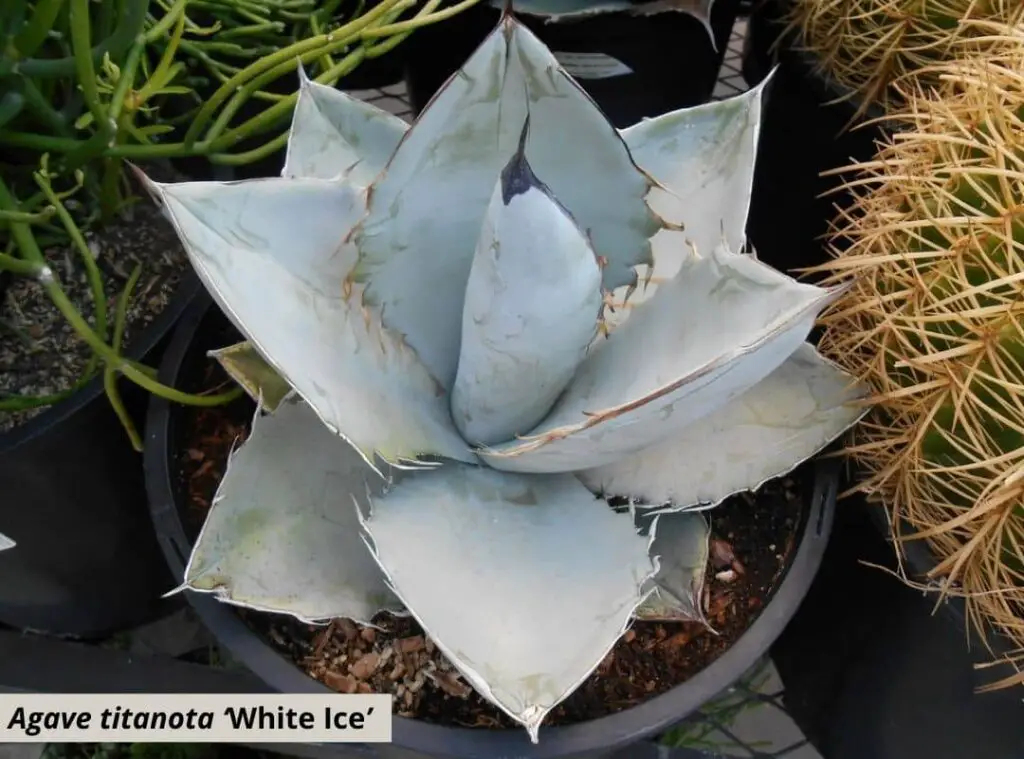
Agave titanota ‘white ice’ is a native plant in Mexico. They would be about 30 inches in width. Agave titanota ‘white ice would usually have whitish gray leaves.
You could grow them both outdoors and indoors depending on the climate conditions.
However, people who have kids will have second thoughts of growing them indoors as they have spiny leaves and an irritating sap. White ice is a slow growing set of plants.
This white succulent prefer USDA hardiness zones 9a-11. Titanota plants tend to form solitary rosettes and they would be 1’-2’ feet in height and 2’-3’ feet in width.
On the other hand, their leaves would be 2’ feet in length and 5 inches in width. In terms of flowering, they would produce blooms in yellow.
Hoya kroniana
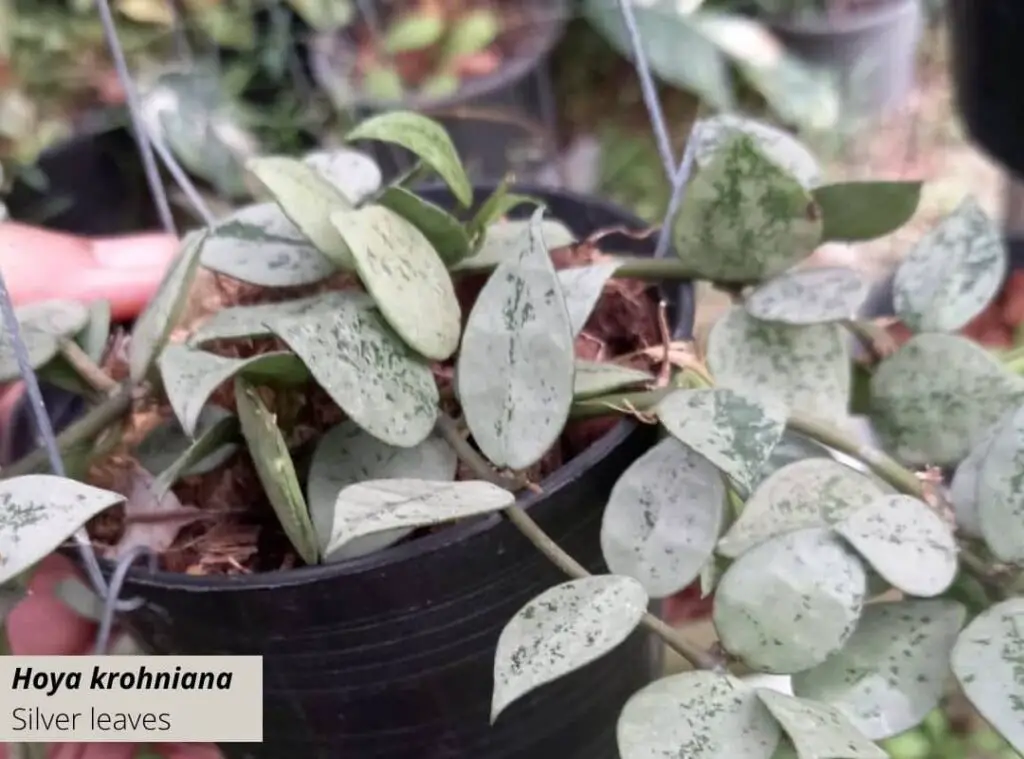
Hoya Kroniana silver leaves contain striking sleeves in silver. They are native plants in the Philippines. Hoya Kroniana silver leaves are a fast growing set of plants.
They usually have thick and waxy leaves and that is exactly why they are called waxy plants.
Their leaves resemble heart shapes. This white succulent would greatly fit in for indoor gardening. Best is to grow them in hanging baskets indoors.
You could expect them to bloom in creamy white flowers.
Echeveria akaihosi
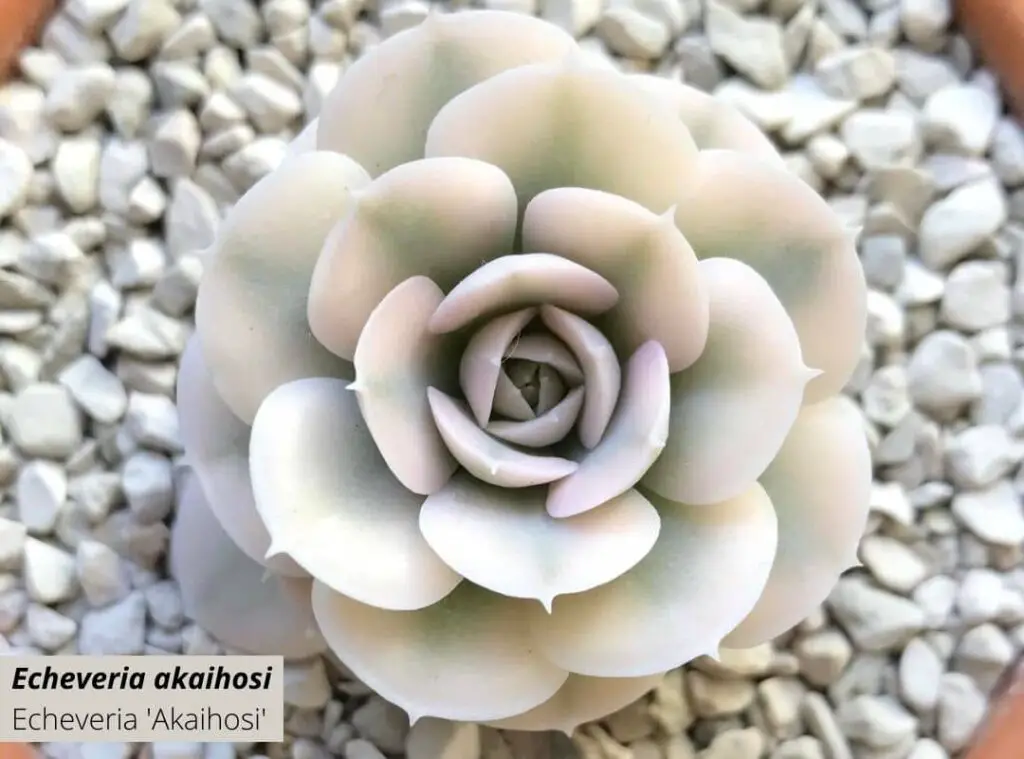
Echeveria akaihosi are a rare yet attractive white succulent. These are native plants in Japan. Chances are that you could spot them in bright orange when they are in stress.
They have thicker leaves and form in rosette types.
Echeveria ‘Lola’

Echeveria Lola is an outcome of a cross between Echeveria Lilacina and Echeveria Deresina. Lola plants tend to look white due to their thick layer of farina on the leaves.
That characteristic makes them look like a snowy white plant. You could spot an undertone of mind and rose under the white.
They would usually form in a sculptured rosette form. Further they would tend to take a rosebud shape as well.
You could expect them to flower in yellow- or peach-colored flowers. They would usually rise to 6 inches (15cm) in height.
Their preferred USDA zones would be Zone9, Zone10 and Zone 11. These plants could usually grow vigorously outdoors. Having said that, you could grow them as indoor plants as well.
Echeveria cante

Echeveria cante are renowned as attractive looking plants. When they mature, they will be about 30 cm (12 inches) in diameter.
On the other hand, they will rise to 6 inches – 9 inches in height. You could spot their leaves in fleshy purple to light purple.
Further they would consist of red edges as well. They would be oblong shaped too. In terms of flowering, these plants would produce yellow to orange flowers. These are rosettes forming succulents
Echeveria cante would prefer to grow in USDA 9b-11b zones. ( -3.9°C (25°F). Echeveria cante are native plants in Mexico.
Their leaves would comprise a thick powdery whitish lavender coating. If you live in aforesaid zones, you may grow them as outdoor plants. Further you could grow them as indoor plants as well.
Related question
Is white succulent real?
White succulent is real. They would be the perfect set of plants if you wish to add a peaceful and positive touch to your garden.
White succulent could be so handy in using centerpieces and living wall projects as well. There could be certain succulents which look like snow-white plants as well.
What does it mean when a succulent turns white?
If you spot your succulent is turning white, that could be an indication of overwatering. Over watering could be the biggest culprit in many diseases of the plant.
It could lead to root rot in the plant as well. In addition to over-watering, sunburns could also cause these plants to turn white.
If you expose the succulents to extreme heat for prolonged periods, that could lead to turning their leaves into white.
Apart from that powdery mildew or pests attack could also result in turning your succulent white.
How do you take care of white succulent?
- Expose them for adequate sunlight
- You could be tactful in rotating the succulents to make sure that they get sunlight evenly.
- Water them appropriately depending on the season
- Water the soil directly and avoid watering them on the leaves of the plant
- Always keep the surrounding of your succulents clean
- Grow them in a container which has adequate number of draining holes
- Grow them in the right soil mix
- Safeguard your plants from pests’ attacks and from other diseases.
What succulent has white flowers?
Jade plants usually bloom with white flowers. They have inherited a name called luckiest houseplant.
Their flowering is not something which could happen frequently though. However, you need to provide them with growing conditions which are quite similar to their natural habitat in order to make sure they bloom.
Their growing requirements are such as cool nights, bright days and moderate watering etc.
Conclusion
Before winding this up, trust this article was helpful for you to decide as to what kind of white succulent you would wish to own.
Further I hope you are much more inspired to grow white succulent after reading this article. White succulent could be handy in using for wedding decorations as well as in wedding accessories too.
They look classy, peaceful and add a sense of positivity to the whole landscape. So, why wait? start growing these wonderful succulents and enjoy watching them flourishing.
Read Next: Black succulents | 13 Unique Black Beauties For Your Garden |
